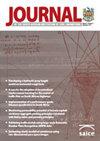Kovacs 1988年区域最大洪水方法的评价
IF 0.6
4区 工程技术
Q4 ENGINEERING, CIVIL
Journal of the South African Institution of Civil Engineering
Pub Date : 2023-03-23
DOI:10.17159/2309-8775/2023/v65n1a4
引用次数: 0
摘要
水工建筑物的设计和评价需要设计洪峰的估算。在20世纪60年代到80年代后期发展起来的方法,例如区域最大洪水(RMF),被用来估计南非的极端洪水峰值。RMF方法使用包络曲线来估计南非及其邻国特定地区可预期的最大洪水,并代表了其他洪水估计方法的指示性洪水上限。科瓦奇为南非开发的方法最近一次更新是在1988年。使用超过30年的额外数据进行分析,本文突出了RMF的明显缺点。在两个RMF区域,更新后的观测洪峰超过了现有的包络曲线。在评估站点的78%的集水区中,站点RMF值比观测到的最大洪峰值至少高出50%。当比较1988年Kovacs和现在DWS(水和卫生部门)数据集的不同参数时,98%的评估站点记录/报告的洪水峰值不同,而33%的站点记录的集水区大小不同。Kovacs 1988使用RMF来估计不同发生概率下的洪峰的比率,发现通常高估了预期的洪峰。结论是1988年RMF方法需要更新,以便仍然提供有关的指导。本文章由计算机程序翻译,如有差异,请以英文原文为准。
Evaluation of Kovacs 1988 Regional Maximum Flood Method
Estimation of design flood peaks is required for the design and evaluation of hydraulic structures. Methodologies developed between the 1960s and the late 1980s, such as the Regional Maximum Flood (RMF), are used to estimate extreme flood peaks in South Africa. The RMF method uses envelope curves to estimate the maximum flood that can be expected in a specific region in South Africa and neighbouring countries, and represents an indicative upper flood limit for other flood estimation methods. The method developed by Kovacs for South Africa was last updated in 1988. Using more than 30 years of additional data for analysis, this paper highlights the RMF's perceived shortcomings. In two RMF regions, updated observed flood peaks exceeded the existing envelope curves. In 78% of the catchment areas of the evaluated stations, the station RMF values were at least 50% more than the observed maximum flood peak. When the different parameters from the Kovacs 1988 and present DWS (Department of Water and Sanitation) datasets were compared, 98% of the evaluated stations had different flood peaks recorded/reported, while 33% of the stations logged different catchment area sizes. Kovacs 1988 ratios used to estimate flood peaks at different probabilities of occurrence, using the RMF, were found to generally over-estimate expected flood peaks. It is concluded that the 1988 RMF method needs to be updated to still provide relevant guidance.
求助全文
通过发布文献求助,成功后即可免费获取论文全文。
去求助
来源期刊
CiteScore
0.70
自引率
25.00%
发文量
19
审稿时长
>12 weeks
期刊介绍:
The Journal of the South African Institution of Civil Engineering publishes peer reviewed papers on all aspects of Civil Engineering relevant to Africa. It is an open access, ISI accredited journal, providing authoritative information not only on current developments, but also – through its back issues – giving access to data on established practices and the construction of existing infrastructure. It is published quarterly and is controlled by a Journal Editorial Panel.
The forerunner of the South African Institution of Civil Engineering was established in 1903 as a learned society aiming to develop technology and to share knowledge for the development of the day. The minutes of the proceedings of the then Cape Society of Civil Engineers mainly contained technical papers presented at the Society''s meetings. Since then, and throughout its long history, during which time it has undergone several name changes, the organisation has continued to publish technical papers in its monthly publication (magazine), until 1993 when it created a separate journal for the publication of technical papers.

 求助内容:
求助内容: 应助结果提醒方式:
应助结果提醒方式:


